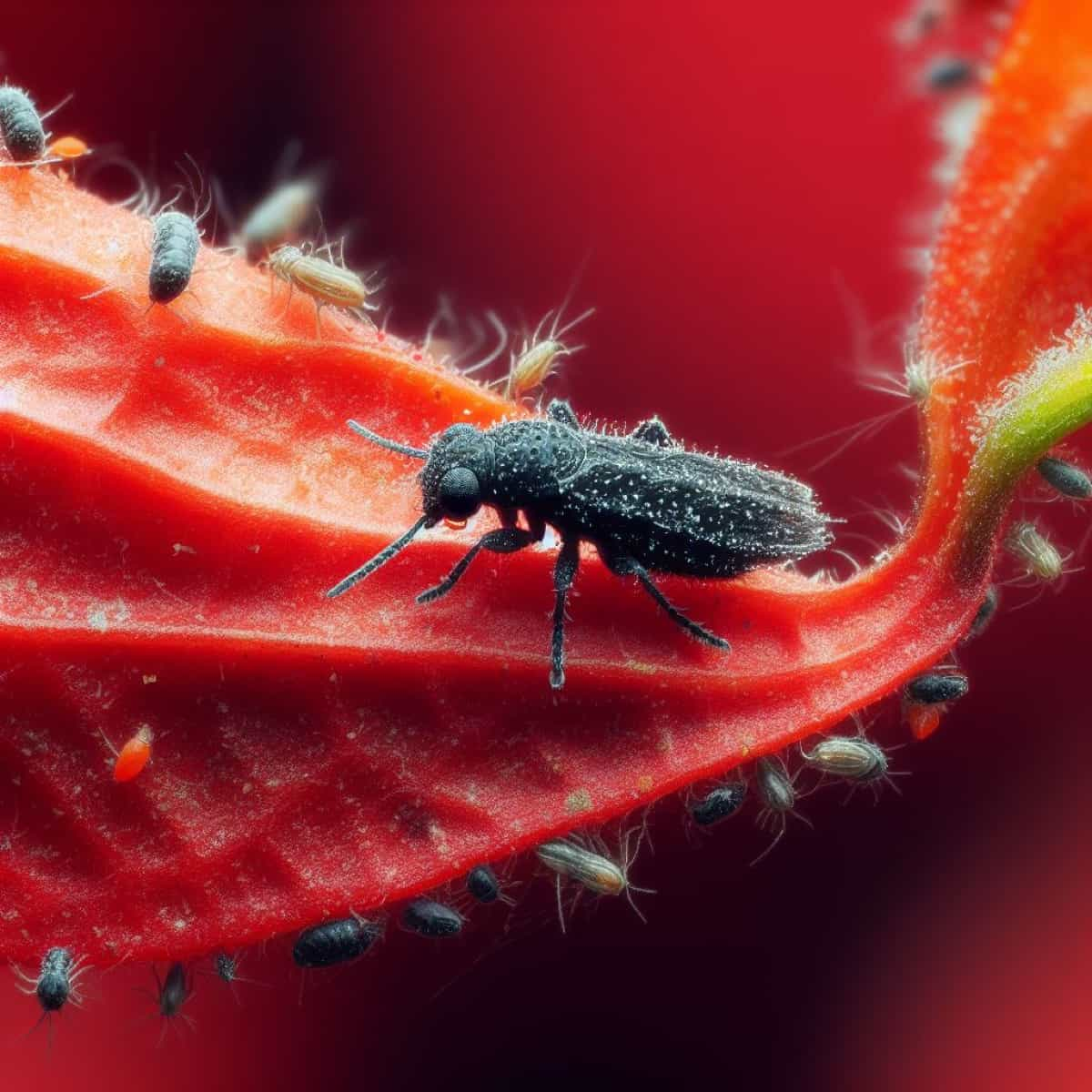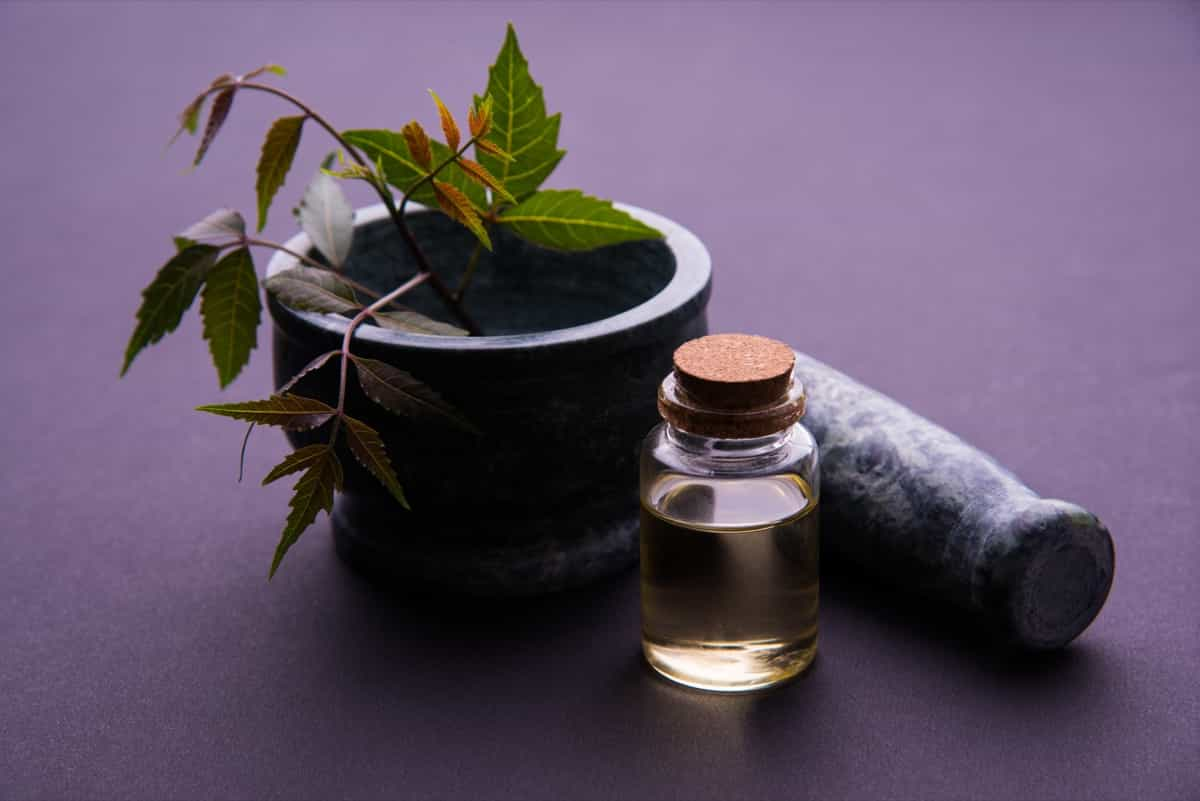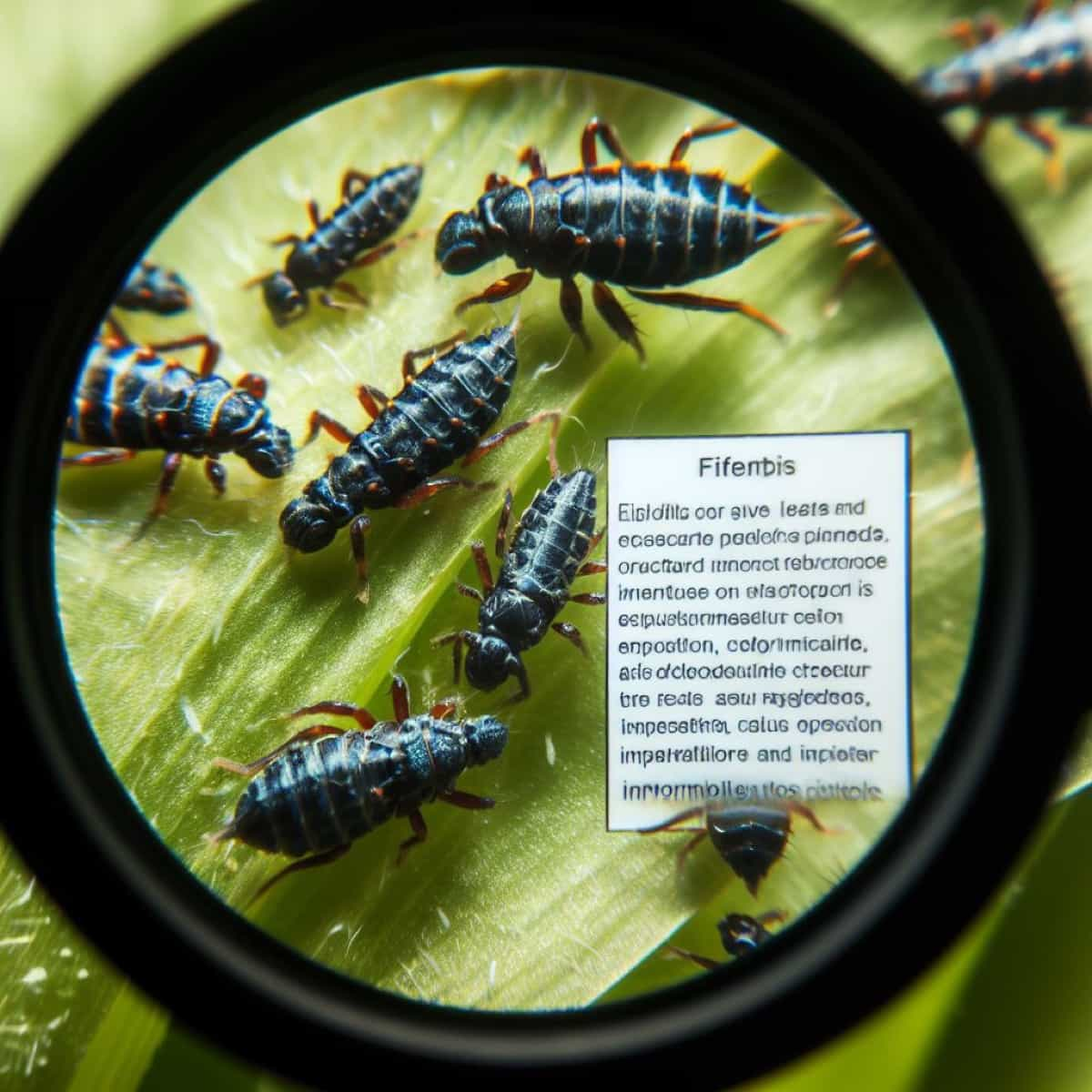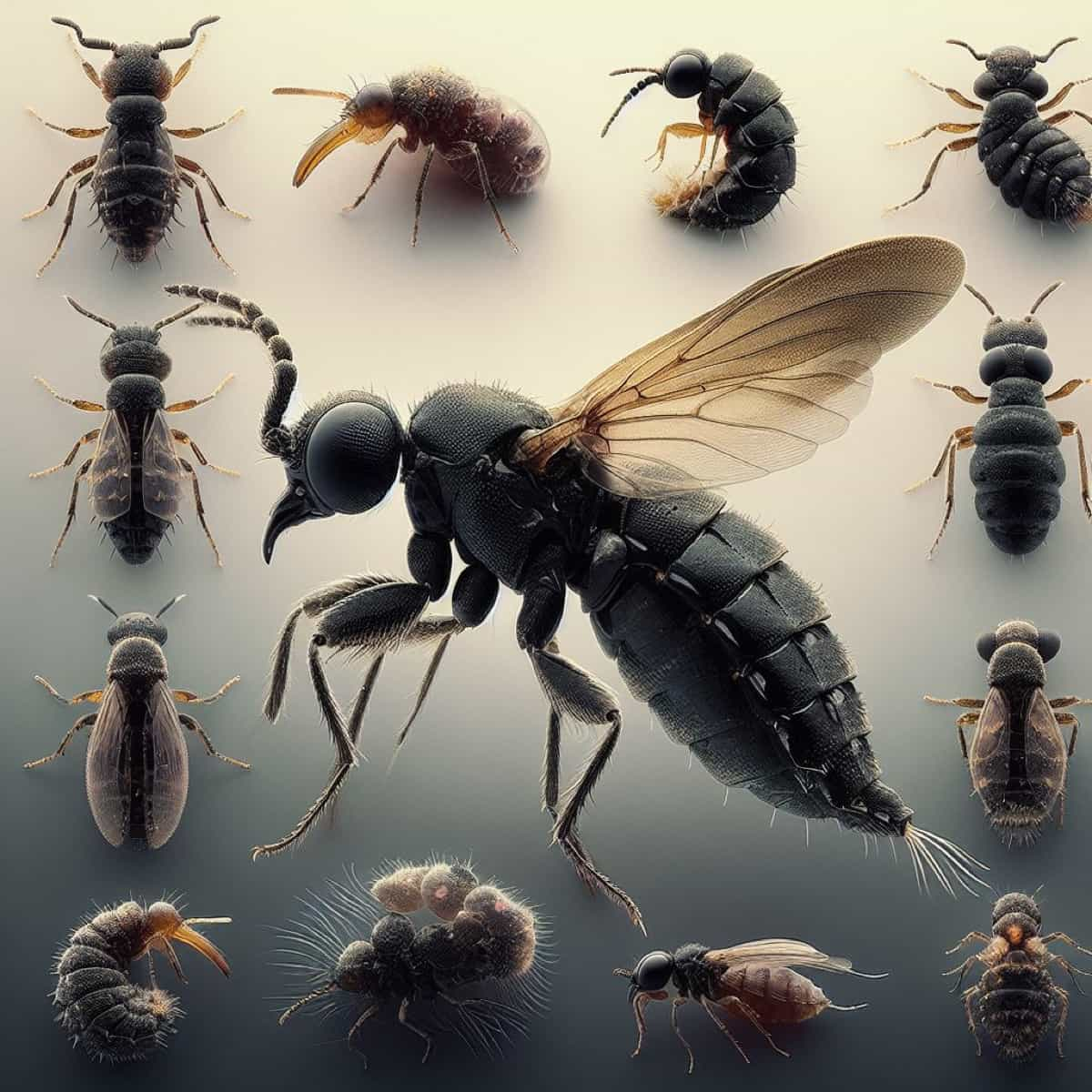In the battle against black thrips, a pervasive pest in agriculture and gardening, selecting a suitable insecticide is crucial. These insects can cause damage to plants, leading to reduced yield and quality. This article will explore the top 10 insecticides proven effective in managing black thrips. Our focus is on products that offer high efficacy, safety, and environmental compatibility. Whether you’re a professional farmer or a home gardener, this guide will help you choose the best solution for protecting your plants from black thrips.

Black Thrips and Lifecycle
Black thrips are tiny insects that feed on chili pepper plants and other crops, causing leaf curling, stunted growth, and reduced yield. They also transmit viruses that can cause further damage to the plants. The life cycle of black thrips is similar to that of other thrips species. Females insert their eggs inside plant tissue, where they hatch in 6-8 days.
The larvae pass through two stages, consuming enough food to complete development to adulthood. Adults, nymphs feed on tender leaves and growing shoots. The life cycle of black thrips can be completed in 9-30 days, depending on the temperature and host plant. Black thrips can have many generations yearly and overwinter in plant debris or soil.
Black thrips, or chili thrips, are a significant pest of chili pepper plants and other crops. They are tiny insects that belong to the family Thripidae. These pests are known for damaging various crops, including chili pepper plants. They feed on the leaves and fruits of chili plants, causing leaf curling, stunted growth, and reduced yield. They also transmit viruses that can cause further damage to the plants. Black thrips control requires cultural, biological, and chemical methods.
10 Best Insecticides for Black Thrips
Neem oil
Neem oil is most used natural insecticide derived from the neem tree’s seeds. Neem oil has antifeedant, repellent, and growth-regulating effects on black thrips and other insects. Neem oil sprayed on the plants at a concentration of 0.5-1% once every 7-10 days.
In case you missed it: How to Manage Black Thrips in Capsicum: Control and Prevention Strategies

Pyrethrin
Pyrethrin is a botanical insecticide extracted from the pyrethrum plant’s flowers. Pyrethrin has a fast knockdown effect on black thrips and other insects. Pyrethrin can be sprayed on the plants at a concentration of 0.01-0.05% as needed.
Spinosad
Spinosad is a microbial insecticide produced by a soil bacterium called Saccharopolyspora spinosa. Spinosad has a stomach and contact action on black thrips and other insects. Spinosad can be sprayed on the plants at a concentration of 0.02-0.08% once every 10-14 days.
Bacillus thuringiensis (Bt)
Bacillus thuringiensis is a bacterial insecticide that produces toxins specific to certain insects. Bt has a stomach action on black thrips and other insects. It can be sprayed on the plants at a concentration of 0.5-1% once every 7-10 days.
Heterorhabditis bacteriophora
Heterorhabditis bacteriophora is a parasitic nematode that infects and kills black thrips and other insects. Heterorhabditis bacteriophora applied to the soil at 2-5 million nematodes per hectare every 15-30 days.
Bacillus sphaericus
Bacillus sphaericus is a bacterial insecticide that produces toxins specific to certain insects. Bacillus sphaericus has a stomach action on black thrips and other insects. Bacillus sphaericus can be sprayed on the plants at a concentration of 0.5-1% every 7-10 days.
Spiromesifen
Spiromesifen is a chemical insecticide that belongs to the tetronic acid group. Spiromesifen has an ovicidal and larvicidal action on black thrips and other insects. Spiromesifen can be sprayed on the plants at a concentration of 0.015-0.03% once every 10-14 days.
Azadirachtin
Azadirachtin is a natural insecticide derived from the seeds of neem trees. Azadirachtin has antifeedant, repellent, growth-regulating, and sterilizing effects on black thrips and other insects. Azadirachtin can be sprayed on the plants at a concentration of 0.01-0.05% once every 7-10 days.
In case you missed it: Top 10 Best Insecticides for Black Thrips Management

Methomyl
Methomyl is a chemical insecticide that belongs to the carbamate group. Methomyl has a stomach and contact action on black thrips and other insects. Methomyl can be sprayed on the plants at 0.025-0.05%.
Chlorpyrifos
Chlorpyrifos is a chemical insecticide that belongs to the organophosphate group. Chlorpyrifos has a stomach, contact, and fumigant action on black thrips and other insects. Chlorpyrifos can be sprayed on the plants at a concentration of 0.05-0.1% as needed.
Best Insecticides for Black Thrips Management: Application and Mode of Action
Cultural methods include crop rotation, intercropping, trap crops, infected plant removal, and reflective mulches. Biological methods include using natural enemies such as predatory mites, lacewings, and ladybugs. Chemical methods involve spraying insecticides that are effective against black thrips.
- Keefun: This insecticide contains Tolfenpyrad, which has an anti-feeding mode that stops the thrips from feeding on the plants. It is effective on thrips in different stages of development.
- Delegate: This insecticide belongs to the spinosin class and contains Spinetoram, a bacterial extract that acts fast and kills the thrips. It has a translaminar action and is effective in low doses. It does not harm beneficial insects.
- Abamectin: This insecticide is derived from a soil bacterium and has a neurotoxic effect on the thrips. It is one of the most effective products registered for thrips control.
- Methiocarb: This insecticide is a carbamate that inhibits the enzyme acetylcholinesterase in the thrips, causing paralysis and death. It is also one of the most effective products registered for thrips control.
How to Control and Apply Insecticides for Black Thrips
To control black thrips effectively, you must monitor the population regularly and apply insecticides when the threshold level is reached. The threshold level for black thrips is 10-15 per leaf or 5-10 per flower. You also need to rotate insecticides with different modes of action to prevent resistance development.
- Choose an appropriate insecticide based on the label recommendations, efficacy, safety, and cost.
- Mix the insecticide with water according to the label instructions.
- Spray the insecticide on the plants using a knapsack or boom sprayer.
- Cover all parts of the plants, especially the lower surface of the leaves and the flowers where the thrips are most active.
- Repeat the application based on the label instructions and the pest situation.
In case you missed it: Homemade Insecticides for Mushrooms: How to Get Rid of Pests in Mushrooms with DIY Recipes

Conclusion
Effectively managing black thrips involves using the proper insecticides, like spinosad, imidacloprid, and neem oil, combined with correct application techniques. Regular monitoring and safe, targeted use of these products can significantly reduce thrips damage in crops and gardens.
- Beneficial Insects in Pest Management
- Natural Solutions for Pest Control in Flower Gardens
- Types of Fungicides Used in Agriculture
- Common Issues in the Fruit Development Stage of Pomegranate Farming
- Fruit Development Issues in Papaya: Easy Solutions and Treatment
- Soil-Borne Diseases and How to Protect Your Plants
- Practices to Prevent Disease Spread in the Garden
- From Wilted to Thriving: How to Treat Root Rot Naturally in Houseplants
- Natural Remedies to Cure Brown Spots on Fig Tree Leaves